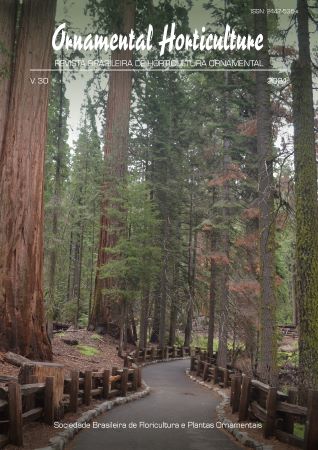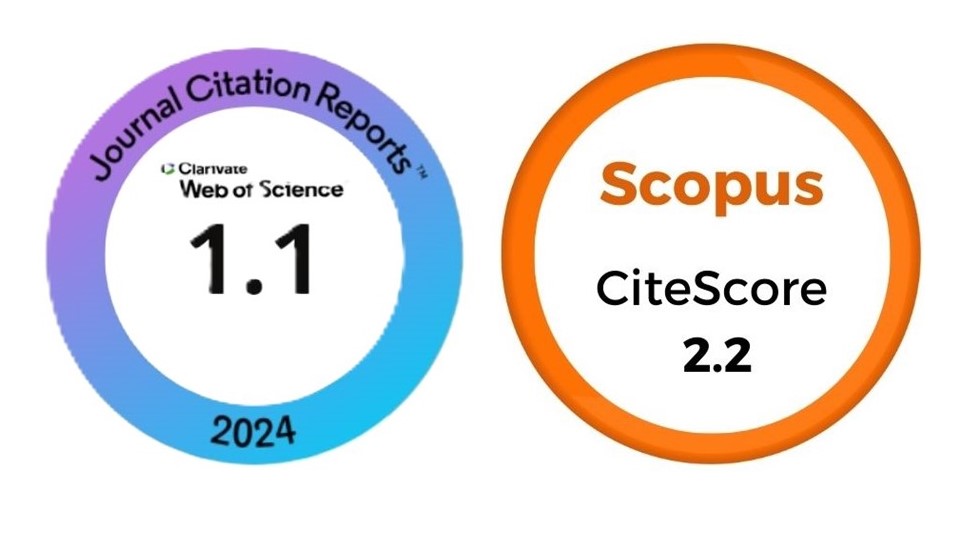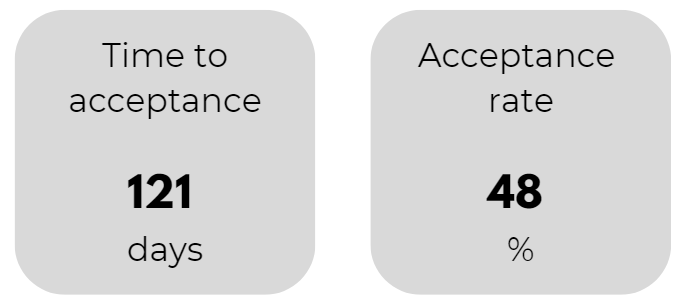Physiological and agronomic characters of commercial cultivars heliconias (Heliconia sp.) in Veracruz, Mexico
DOI:
https://doi.org/10.1590/2447-536X.v30.e242730Keywords:
agroforestry systems, commercial potential, environmental potential, ornamental plants, subgenus heliconia, tropical flowersAbstract
Heliconias belong to the group of tropical flowers, which generate economic benefits in the agricultural sector with their agronomic peculiarities. Besides providing the social actors involved with benefits aimed at sustainability in different tropical areas. Therefore, the objective of this study was to compare the physiological and agronomic characteristics of three commercial cultivars of Heliconias in three locations of a community in the municipality of Fortín, in the state of Veracruz, Mexico. Three sites were identified based on the type of agriculture: agroforestry system with Heliconias (site 1), agroforestry system - monoculture, with Heliconias (site 2) and monoculture (only Heliconias, site 3). A randomised complete block design with a split-plot arrangement (A x B) and six replications was used. Factors were: A) In situ cultivation sites, corresponding to three plots (sites) in the municipality of Coapichapan, Mexico, and B) Heliconias cultivars (Heliconia psittacorum, Heliconia wagneriana and H. bihai). The variables evaluated were tillers traits and inflorescence traits. The results show that in an agroforestry system with Heliconia, Heliconia bihai showed better performance in eight variables except for inflorescence number and bract number. In an agroforestry and monoculture system with Heliconia, Heliconia bihai shows better results in leaf length and inflorescence length. In an agroforestry system and monoculture with Heliconia, Heliconia wagneriana performed better in bract number, pseudostem width and leaf length. In monoculture, Heliconia bihai responded best to inflorescence length. Due to the tropical nature of this ornamental, the best growing conditions for Heliconia are in agroforestry systems. Due to its physiological characteristics, Heliconia bihai shows its agronomic potential in this type of agriculture even under monoculture conditions. Therefore, the conditions offered by an agroforestry system have a positive effect on the cultivation of Heliconia.
Downloads
References
ANDERSSON, L. Revision of Heliconia sect. Heliconia (Musaceae). Nordic Journal of Botany, v.1, n.6, p.759-784, 1981.
AVENDAÑO-ARRAZATE, C.H.; ARRAZATE-ARGUETA, J.A.; ORTÍZ-CURIEL, S.; MORENO-PÉREZ, E.; IRACHETA-DONJUAN.; REYES-LÓPEZ, D.; GRAJALES-SOLÍS, M.; MARTÍNEZ-BOLAÑOS, M.; CORTÉS-CRUZ, M. Morphological characterization in wild species of Heliconias (Heliconia spp.) in Mexico. American Journal of Plant Sciences, v. 8, n.6, p.143, 2017. https://doi.org/10.4236/ajps.2017.86080
BALTAZAR-BERNAL, O.; ZAVALA-RUIZ, J.; GAYTÁN-ACUÑA, E.; CAAMAL-VELÁZQUEZ, J. La floricultura tropical: un complemento del turismo rural en la zona centro del estado de Veracruz, México. Agro Productividad, v.11, n.8, p.6, 2018. https://doi.org/10.32854/agrop.v11i8.1093
CARRERA-ALVARADO, G.; VELASCO-VELASCO, J.; OSORIO, C. G.; SALINAS-RUÍZ, J.; BALTAZAR-BERNAL, O. Producción de heliconias en municipios de Veracruz. Agro Divulgación, v.3, n.1, p.75-80, 2023. https://doi.org/10.54767/ad.v3i1.143
CHENG, X.; YANG, T.; SHI, C.; LIU, X. Exploring Heliconia chloroplast genomic features through assembly and analysis of four complete chloroplast genomes. Research Square, p.1-21, 2024. https://doi.org/10.21203/rs.3.rs-3849310/v1
DÍAZ, D.; MARTÍNEZ, J. Análisis sobre el desarrollo del sector florícola en el ejido Llano de La Lima, Tapachula, Chiapas. Revista Mexicana de Agronegocios, v.52, n.2023, p.369-376, 2023. https://doi.org/10.22004/ag.econ.337033
DUQUE-NIVIA, A.; LÓPEZ-GUTIÉRREZ, A.M.; ISAZA-VALENCIA, L.; ARIAS-VILLEGAS, J.; MARULANDA-ÁNGEL, M.; LÓPEZ-MORA, P.A. Diversidad genética de las heliconias y su aplicación en fitorremediación, identificación varietal y mercadeo. Colombia: Editorial Universidad Tecnológica de Pereira, 2022. 124p.
FARRELL, J.G.; ALTIERI, M. A. Sistemas agroforestales. Agroecología: Bases científicas para una agricultura sustentable. Nordan-Comunidad, Montevideo, 1999. p.229-243.
GOMES, R.J.; GUISELINI, C.; SIQUEIRA, G.M.; ALBUQUERQUE FILHO, J.; LOGES, V.; JÁCOME-CHACÓN, M.; TREJO-TÉLLEZ, L.; PÉREZ-SATO, J.; GARCÍA-ALBARADO, J.; CUACUA-TEMIZ, C.; GÓMEZ-MERINO, F.C. Consideraciones sobre manejo fitosanitario, nutrimental y postcosecha de heliconias para su comercialización. Agro Productividad, v.11, n.8, 2018.
KANNAN, M.; JAWAHARLAL, M.; RANCHANA, P. Evaluation of Heliconia genotypes for genetic, yield and quality parameters. Acta Horticulturae, v.1241, p.209-214, 2019.
KIM, D.; GRIECO, E.; BOMBELLI, A.; HICKMAN, J.; SANZ-COBENA, A. Challenges and opportunities for enhancing food security and greenhouse gas mitigation in smallholder farming in sub-Saharan Africa. A review. Food Security, v.13, p.457–476, 2021. https://doi.org/10.1007/s12571-021-01149-9
KRAUSE, S.; KRAUSE, W.; SANTOS, E.A.; ROSSI, A.A.; CORDEIRO, M.H.M.; SILVA, C.A. Morphological and molecular characterization of native Heliconia sp. accessions of the Amazon region. Ornamental Horticulture, v.29, p.323-332, 2023. https://doi.org/10.1590/2447-536X.v29i2.2578
KUNZE, K. H.; MEINTS, B.; MASSMAN, C.; GUTIÉRREZ, L.; HAYES, P.M.; SMITH, K.P.; SORRELLS, M.E. Genotype×environment interactions of organic winter naked barley for agronomic, disease, and grain quality traits. Crop Science, p.1-19, 2024.
LINARES-GABRIEL, A.; GALLARDO-LÓPEZ, F.; VILLARREAL, M.; LANDEROS-SÁNCHEZ, C.; LÓPEZ-ROMERO, G. Global vision of heliconias research as a cut flowers: a review. Ornamental Horticulture, v.26, n.4, p.633-646, 2020. https://doi.org/10.1590/2447-536X.v26i3.2172
LINARES-GABRIEL, A.; RODRÍGUEZ, N.O.; HERNÁNDEZ-CHONTAL, M.A. Scientific contributions in Heliconias cultivation in Mexico. Tropical and Subtropical Agroecosystems, v. 26, n.1, p.1-15, 2023. http://dx.doi.org/10.56369/tsaes.4446
LOGES, V.; CASTRO, C.E.F.; CASTRO, A.C.R.; GONÇALVES, C. Characteristics of pendent heliconia for use in landscape and as cut flower. Ornamental Horticulture, v.22, n.3, p.287-295, 2016. https://doi.org/10.14295/oh.v22i3.942
LOGES, V.; CASTRO, A.C.R.; TEXEIRA, M.D.C.F.; CASTRO, C.E.I.M.F. Heliconia in Brazil: investigation and the current situation. Bulletin of Heliconia Society International, v.29, n.1, p.7, 2023.
MALAKAR, M.; BISWAS, S. Heliconias: dramatic flowers of the tropics and subtropics. In: DATTA, S.K.; GUPTA, Y.C. (Ed.). Floriculture and Ornamental Plants. Handbooks of crop diversity: conservation and use of plant genetic resources. Singapore: Springer, 2022, p.729-776.
MARQUINA, S.R.; VARELA, J.U.; RANGEL, A.B. Propuesta de incorporación de plantas del género Heliconia sp. como estrategia de conservación y manejo sustentable de sistemas cacaoteros y cafetaleros del Sur del Lago de Maracaibo y Valle del Mocoties, Venezuela. Cuadernos de Biodiversidad, n.53, p.26-32, 2017. https://doi.org/10.14198/cdbio.2017.53.04
NIHAD, K.; BERWAL, M.K.; HEBBAR, K.B.; BHAT, R.A.; HARIS, A.; RAMESH, S.V. Photochemical and biochemical responses of heliconia (Heliconia stricta ‘Iris’) to different light intensities in a humid coastal environment. Horticulture, Environment, and Biotechnology, v.60, n.6, p.799-808, 2019.
PANDORFI, H. Temporal stability of Heliconia spp. flower stem production. Ornamental Horticulture, v.22, n.3, p.318-325, 2016.
RAMÍREZ-SUÁREZ, M.A.; MORENO-HERNÁNDEZ, J.C.; BENÍTEZ-GARCÍA, J.M.; MAZORRA-MANZANO, I.; SÁNCHEZ, E. Strategies for production, characterization and application of protein-based biostimulants in agriculture: A review. Chilean journal of agricultural research, v.80, n.2, p.274-289, 2024.
RANGEL MARQUINA, S.; UZCÁTEGUI VARELA, J.P.; BRICEÑO RANGEL, A. Propuesta de incorporación de plantas del género Heliconia sp. como estrategia de conservación y manejo sustentable de sistemas cacaoteros y cafetaleros del Sur del Lago de Maracaibo y Valle del Mocoties, Venezuela. Cuadernos de Biodiversidad, v.53, p.26-32, 2017.
ROJAS-SANDOVAL, J; ACEVEDO-RODRÍGUEZ, P. Heliconia bihai (macaw flower). CABI Digital Library. 2013. Available at: Accessed on: May 03, 2024.
SILVANO, S.J.; ARREOLA-ENRÍQUEZ, J.; LEYVA-TRINIDAD, D. Evaluation of the Genipa americana L./Heliconia stricta Huber agroforestry system and its effects on soil fertility. Agro Productividad, v.16, p.159-166, 2023. https://doi.org/10.32854/agrop.v16i3.2229
SOUZA, R.R.; CAVALCANTE, M.Z.B.; SILVA, E.M.; AMARAL, G.C. BRITO, L.P.S.; AVELINO, R.C. Growth and changes on morphology and physiology of heliconias according to different shading environments. Comunicata Scientiae, v.7, n.2, p.214-222, 2016.
TÓRREZ, E.F.O.; HERNÁNDEZ, R.J.M.; DÍAZ, J.U.B. Carbono almacenado en sistemas agroforestales con café (Coffea arabica L.) en tres municipios de Boaco, Nicaragua. La Calera, v.23, n.40, 2023. https://doi.org/10.5377/calera.v23i40.16221
VILLAGRAN, E.; ROCHA, G.A.O.; MOJICA, L.; FLORES-VELASQUEZ, J.; AGUILAR, C.E.; GOMEZ, L.; GOMEZ, D.; ANTOLINEZ, A.; NUMA, S. Scientific analysis of cut flowers: a review of the main technical issues developed. Ornamental Horticulture, v.30, p.1-16, 2024. https://doi.org/10.1590/2447-536X.v30.e242699
WILLMOTT, A.; WILLMOTT, M.; GRASS, I.; LUSIANA, B., COTTER, M. Harnessing the socio-ecological benefits of agroforestry diversification in social forestry with functional and phylogenetic tools. Environmental Development, v.47, p.1-15, 2023. https://doi.org/10.1016/j.envdev.2023.100881
XAVIER, T.L.S.; PEREIRA, V.S.; NASCIMENTO, Y.Y.G.; PAIVA NETO, V.B.; SOUZA, R.R.; SILVA, R.R.; BECKMANN-CAVALCANTE, M.Z. Kaolin, boron, and zinc increase photosynthetic activity and mitigate the effects of light stress in heliconia grown under semi-arid conditions. Scientia Horticulturae, v.319, p.112-134, 2023. https://doi.org/10.1016/j.scienta.2023.112134
Downloads
Published
Issue
Section
License
Copyright (c) 2024 Ornamental Horticulture

This work is licensed under a Creative Commons Attribution 4.0 International License.








